|
Posted by KOTriode on
09-06-2011
|
|
fiogf49gjkf0d
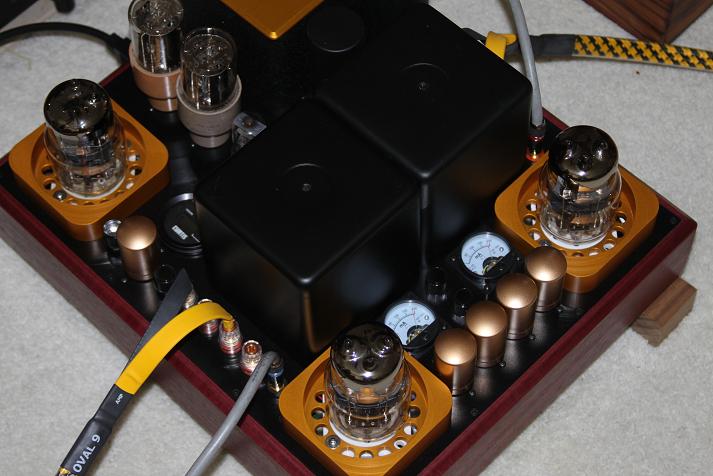
The Melquiades give me inspiration to build this 6C33C amplifier. It's on a stereo chassis that has few unique features
- Vacuum tube rectifier separately for Input/Driver and Output tubes.
- Regulator using the same tube types as the amplifier (for same sonic signature).
- Direct coupling without capacitor in the signal chain (from input to output). I prefer this method over interstage transformer.
- No negative Feedback.
- Can easily be reduced to two stages.
|
|
|
|
Posted by Paul S on
09-07-2011
|
|
fiogf49gjkf0d VERY beautiful, and proper circuit routing, too. So, please tell about the system it's in and the qualities the amp manifests in this system. Maybe share circuit (including PS)?
Best regards,
Paul S
|
|
|
|
Posted by Romy the Cat on
09-07-2011
|
|
fiogf49gjkf0d
 KOTriode wrote: KOTriode wrote: |
The Melquiades give me inspiration to build this 6C33C amplifier. It's on a stereo chassis that has few unique features
- Vacuum tube rectifier separately for Input/Driver and Output tubes.
- Regulator using the same tube types as the amplifier (for same sonic signature).
- Direct coupling without capacitor in the signal chain (from input to output). I prefer this method over interstage transformer.
- No negative Feedback.
- Can easily be reduced to two stages.
|
|
Interning, KOTriode, thanks for sharing. Would you like to publicize the amp security?
The Vacuum tube rectification was greatly debated during the creation of Melquiades. My contusion was that if the soft-switching SS rectification is use and the most important if the input choke filters used with large last cap then there is no need in tube rectification. In addition, I was not able to get bass that I was after with tube rectification.
Regulator. This is a very interesting subject. There was a LOT of debate in Russia of regulator has to be used form 6C33C. Some people feel that it is very much must and others feel opposite. I did single experiment regulating my 6C33C with 3x807 triodes. I was not impressed with the result but I do not insist that my result was definitive. The Jury about the need of regulation is still out in my view. Of cause the most powerful statement of the need of regulation for this tube would be the use of regulation in the best commercial amp built about this tube – Lamm ML-2.0. Still it was a commercial amp and it was “the Vladimir” – there are 2353 other sinister reasons why he would use more tubes in his design. The reality is that I would be very interested to learn how he 6C33C behaves regulated and not regulated. The reason I did not go into the depth of this subject at the time when I worked on Melquiades was my modeling of regulation with my phonostage. I had built a very good regulator around 105V gas voltage reference tube, the 7788 pentode as Arial amplifier and 6C19P triode as the regulator switch. It was working fine (still have it), sounded fine but I detected that it a bit hold the Sound back and did not let to play with “hair down” if you know what I meant. At that time that slightly more polite and overly courteous then I would like it to be sound of my Lamms ML2.0 power amps was exactly what I would like to defeat and it lead me to abandon the regulation as the possible reasons for the “softness”. I do not insist that it was THE reason and I do not mind to try the regulation on 6C33C again. Sure, I will not be doing it now but I am still observing the commentary of others on the subject.
The direct coupling without capacitors or interstage transformers in the signal chain is fine. I juts a bit afraid of this 6C33C tube. It is not type 45 tube and not 2A3 that will run for 45 year with no sign of any problems. This is Russian 6C33C with own stupid behavior and ability crash. I do not know what kind driver you use but it get to be very reliable as if your driver in direct coupling application go down then your 6C33C will fry not only your speaker but half of your house. Talk to the people who use 6C33C for OTLs… BTW, when I saw you use 2 driver tubes per channel I though you use some kind SRPP to drive 6C33C…
Anyhow, it looks like nice amp. The design and assembling techniques are very pleasant. What driver and what kind output transformer you use? Did you find while you was working with 6C33C anything that I did not cover at my site? The most interning: how do you find your amp sound? Can you elaborate about the sound of the amp in greater details? Is anything that you learned, discover, realized from the sound of your amp?
Rgs,
Romy the Cat
|
|
|
|
Posted by KOTriode on
09-07-2011
|
|
fiogf49gjkf0d
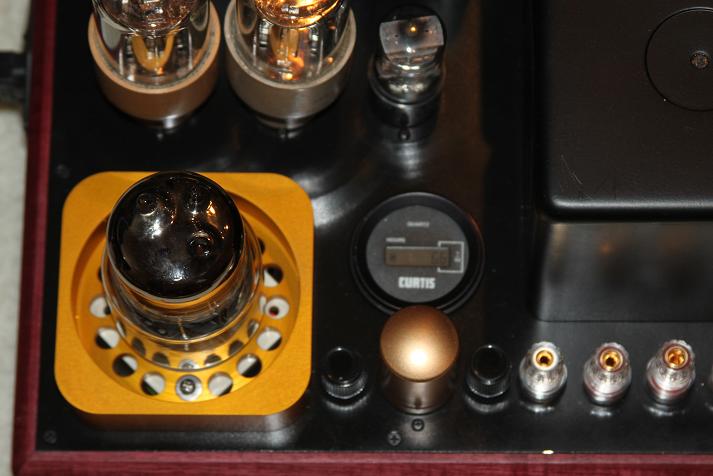
Thank you for the comment on this amp, this is my first time of using the 6C33C tube, I decided to build this amp after reading about the Melquiades, this amp is just a quick experiment on the 6C33C sound, since I have a single chassis intended for a phono/preamp laying around for year now, normally I would build a mono block. I picked up 4 these tubes for less than $50 on my trip to Asia last year, they are harder to find now over there, why? nobody care of these cheap tubes, so nobody stock them any more.
- Vaccum tube rectification/regulator in amplifier: Yes, there is quite a few debate on these subject. Two years ago after building a 845/WE212E amplifier with tube rectification/regulator (yes, with 1200V regulator), and compare the sound with previous rectification/unregulated 845 amplifier, I would never go back. With this 6C33C amp, I have made an extra step in this experiment, using the same tube in the amplifier for the regulator, so that the regulator tube do not add it's own tube sonic signature (I normally used 6AS7 in other regulator). Also, with tube regulator, I did not have to use too much capacitance, and do without choke, saving amplifier real estate and weight. Another strong point for regulator: I can adjust B+ anywhere from 160-220V, and with adjustable bias on the tube from 100ma-300ma, I should be able to find its sweet spot.
- Direct coupling: I used expensive Tango NC20 in my other 845/212E amplifier and was very happy about its sound. I used a lesser interstage in the $500 range on my 300B and was not impressed. So, not willing to buy another pair of NC20 (by the way, a pair of NC20 went for $2300 on Ebay last month) for this 6C33C (cheap) amplifier, I decided on direct coupling (it's free, and I dont have to look for expensive coupling capacitor). For safety, I used a 500ma fuse on the plate. A cathode bias method would have been safer, but with over 30W of heat from cathode bias resistor under the hood will make this amp short lived.
- Input/driver: It's a plate follower direct coupled to a cathode follower. This amp actually only need 1 stage, I installed two sockets just in case (you always need to have plan B) if one stage is not adequate. I threw in the cathode follower stage as an experiment, if I do not like the sound it can be easily removed an replace with a jumper (then, an eye tube will take its place).
It's still too early to tell how this amp sound, as of last night the meter showed only 6.6 hours of break in time (you can barely see the hrs above the "Curtis" hour meter. So far I learned that one of the brand new tube failed with properly heater burn in, it needed -125V bias instead of around -70V. I also learned from the tube seller that you need burn-in 24 hrs just for the heater on these virgin tubes before applying any current. This amp run really hot, the whole chassis get hot, I installed an fan under each power tubes and and it helped a lot. I should able to tell the sound of this tube after about 100hrs on the meter.
|
|
|
|
Posted by Romy the Cat on
09-07-2011
|
|
fiogf49gjkf0d
 KOTriode wrote: KOTriode wrote: | | Thank you for the comment on this amp, this is my first time of using the 6C33C tube, I decided to build this amp after reading about the Melquiades, this amp is just a quick experiment on the 6C33C sound, since I have a single chassis intended for a phono/preamp laying around for year now, normally I would build a mono block. I picked up 4 these tubes for less than $50 on my trip to Asia last year, they are harder to find now over there, why? nobody care of these cheap tubes, so nobody stock them any more. |
|
I am surprised to hear it. The 6C33C is incredibly widely available tube and it is VERY cheap. In the Milq time I was getting them from Russians for under $5 shipped to Boston. I think nowadays they are a bit more expensive but still then are in the range if 12-15 bucks for tube in you buy a quantity of them. They shall be widely available on eBay and everywhere else.
 KOTriode wrote: KOTriode wrote: | | Vaccum tube rectification/regulator in amplifier: Yes, there is quite a few debate on these subject. Two years ago after building a 845/WE212E amplifier with tube rectification/regulator (yes, with 1200V regulator), and compare the sound with previous rectification/unregulated 845 amplifier, I would never go back. With this 6C33C amp, I have made an extra step in this experiment, using the same tube in the amplifier for the regulator, so that the regulator tube do not add it's own tube sonic signature (I normally used 6AS7 in other regulator). Also, with tube regulator, I did not have to use too much capacitance, and do without choke, saving amplifier real estate and weight. Another strong point for regulator: I can adjust B+ anywhere from 160-220V, and with adjustable bias on the tube from 100ma-300ma, I should be able to find its sweet spot. |
|
I am not convinced by “I would never go back” comment. In addition I think that each type of tube, each type of biasing and each specific application might response differently to the benefits of regulation. Your experience with tungsten-coated direct heated tune might be very different with indirect heated tubes. What I am trying to say is that I would find your experience more educational if you use the same 6C33C in the same application with and without regulation. For instants I was able to get much more interesting sound regulating the screen supply of phonostage input pentode (7788). Still, if I regulated with the same regulator the 6C33C grid supply then it was disasters to sound. So figure…
Another very important reason why I do not regulate my 6C33C is that you have mentioned – the regulation does not go with input chokes and large caps. Regulator does not drive them well and mostly I saw after regulator very flimsy filtration. This all make the stage to sound pretty much like the “sound of regulator”. I do not like it. I tend to stabilize current with very big and heavy PS along with strictly input chokes. The adjustable current on the tube from 100ma-300ma and 160-220V? Why do you need it? The experiments with tube operational parameter people do during the design phase and in most of the case the tune is drive from external power supply. I use Fluke 409, half-ampere, 600V PS with two dozen tubes in it. In the operational amp there is no need to change current so much. Also, if you change the current from 100ma-300ma then you change the plate impedance too much to keep the same transformer ratio…
 KOTriode wrote: KOTriode wrote: | | It's still too early to tell how this amp sound, as of last night the meter showed only 6.6 hours of break in time (you can barely see the hrs above the "Curtis" hour meter. So far I learned that one of the brand new tube failed with properly heater burn in, it needed -125V bias instead of around -70V. I also learned from the tube seller that you need burn-in 24 hrs just for the heater on these virgin tubes before applying any current. This amp run really hot, the whole chassis get hot, I installed an fan under each power tubes and and it helped a lot. I should able to tell the sound of this tube after about 100hrs on the meter. |
|
The hrs meter was a great move. I would like to have it on my amp but it is too late. Post your observation about sound when you feel you are ready. Also, be advised that 6C33C is indirect heated it means it will not work in A2. With your former 845/WE212E if your driver was able to drive them with plate currents then these DHT more or less were operational on the “negative side” the 6C33C will clip VERY sharply. I do not know what you drive with this amp and what the size of your room but make sure that it does not send the 6C33C to A2. H
http://www.goodsoundclub.com/Forums/ShowPost.aspx?PostID=6057
Rgs,
Romy the Cat
|
|
|
|
Posted by KOTriode on
09-08-2011
|
|
fiogf49gjkf0d
Without regulation, this amp would not work correctly due to its design: DC coupled and fixed bias. The high transconductance will make the bias current varied as much as 50-100ma due power line fluctuation without the regulators. It might work if the amp used cathode bias, but I chose fixed bias for various reason. The input stage (with or without the Cathode follower stage) bias the output tube from the plate voltage, fluctuation in unregulated B+ will cause the grid voltage to swing which in turn change the output tube bias current. Transformer with high current output, choke and capacitor would not help much with this design with line voltage fluctuation.Also since this is a setreo amp, good regulator definitely help crosstalk.All my systems are multi-amp and put a heavy load on the power line on the average of 1000W and more, so regulator in this amp is necessary, not an option.
Why the adjustable voltage? this tube to me is an experiment, the regulator for me is very convenient to understand the bias of this tube with different plate and grid voltage in the amplifier, and how the sound will be affected with different operating point. I am not too crazy building a high voltage amp (the voltage is as high as 520V on this amp) with multiple power supply and wire hanging.
This amp is never intended to work in A2, so does my other DHT amp. The amp can be played with or without the Cathode follower, my aim to get the driver as linear and wide bandwidth as possible, hence feedback will be unnecessary.
I will try the amp with few different speakers as full range and later in tri-amp system, among them are mini monitor, Stacked Quad ESL, Horn system.... It would be very interesting to compare with the big DHT tube. Into the 10 hrs of break-in with a monitor, I am very happy with the sound so far.
|
|
|
|
Posted by Romy the Cat on
09-08-2011
|
|
fiogf49gjkf0d
 KOTriode wrote: KOTriode wrote: |
Without regulation, this amp would not work correctly due to its design: DC coupled and fixed bias. The high transconductance will make the bias current varied as much as 50-100ma due power line fluctuation without the regulators. It might work if the amp used cathode bias, but I chose fixed bias for various reason. The input stage (with or without the Cathode follower stage) bias the output tube from the plate voltage, fluctuation in unregulated B+ will cause the grid voltage to swing which in turn change the output tube bias current. Transformer with high current output, choke and capacitor would not help much with this design with line voltage fluctuation.Also since this is a setreo amp, good regulator definitely help crosstalk.All my systems are multi-amp and put a heavy load on the power line on the average of 1000W and more, so regulator in this amp is necessary, not an option.
Why the adjustable voltage? this tube to me is an experiment, the regulator for me is very convenient to understand the bias of this tube with different plate and grid voltage in the amplifier, and how the sound will be affected with different operating point. I am not too crazy building a high voltage amp (the voltage is as high as 520V on this amp) with multiple power supply and wire hanging.
This amp is never intended to work in A2, so does my other DHT amp. The amp can be played with or without the Cathode follower, my aim to get the driver as linear and wide bandwidth as possible, hence feedback will be unnecessary.
I will try the amp with few different speakers as full range and later in tri-amp system, among them are mini monitor, Stacked Quad ESL, Horn system.... It would be very interesting to compare with the big DHT tube. Into the 10 hrs of break-in with a monitor, I am very happy with the sound so far. |
|
KOTriode, I think you are missing what I am trying to say. It is very much not the debate of the usefulness of regulation but rather me stressing the point that neither yours nor my experience with regulation does not provide a universal answer if the 6C33C might be benefited by regulation.
It is not doubts that your design needs to be regulated to stabilize all your direct coupled operational parameters. However, your regulation does not address the needs of 6C33C but rather serves the environmental purposes. So, even in your design we do not know how 6C33C will sound in the same application with no regulation. BTW, I regulate my power AC supply – here is another way to stabilize operation without use of DC regulators.
If you look closely then you will see that in Melquiades I use regulation on the grid supply of the driver tube. I do have very substantial advantage on sound quality but here is an interesting question: do I have this advantage become of regulation of because some other reason? The negative regulator in Melquiades drives the driver grid. The grid has own minute grid voltages that run back to the PS. Here on the PS side we have gas regulator – a very soft entry that instead of hard-shorting grid voltages or bouncing them back, the gas regulator very gently absorbs them. So, it is possible that in my case the regulation itself is not important but rather that I use the regulation as some sort of damper that sucks out the reflective voltages from driver grid. If cause if I go with voltage stabilization on negative side on the biasing grid resistor then I need to have one on positive side to lock the bias. BTW, try the same biasing approach on the 6C33C and it will not sound good at all.
What I am trying to say is that so far I do not see any evidence for or against regulation of 6C33C. Neither your use of mandatory for your circuit regulation not my “creatively-intentional” use of bias regulation does not say anything about the regulation and it benefits for sound of 6C33C.
About the A2. I do not say that you intended to be in A2 but driving the 86dB sensitive Quad in a room larger then a dog house your bass will be jumping for a fraction of seconds into A2. The 845/211, beside to having more power will handle this entering into A2 with some distortions but it will still be fine and the signal will be cared on. The 6C33C will not even go into A2 – it will flat cut the signal producing enormous amount of distortions across all bandwidth. All the I a saying is that being indirect heated the 6C33C is much deadlier with grid voltage approaching the bias voltage. If you have 65V on grid and 30-40 times gain in your driver stage then it is not difficult to be “right there” very fast. Sine you use an extra buffer stage, useless people do it to get current drive then I remind you that it would be fine with DHT 845/211 but it will not “help” to any indirect heated output stage.
About the 6C33C vs. 845/211. This might be interesting. Are your 845/211 also regulated and direct coupled with use of the same Tango magnetics? Are they use the same Tango’s vintage? The Tango 20 years back was very much not the crap that Tango dose nowadays, if you know what I mean…
I personally feel that 845 is in a way vulgar tube but 211 is very-very nice tube. I do not know how the Quad ESL – 6C33C never was good to drive them but I would like to hear your observations about 6C33C driving your horns.
The caT
|
|
|
|
Posted by KOTriode on
09-08-2011
|
|
fiogf49gjkf0d
Yes, it would be very interesting to hear the difference between a 6C33C amp with and without tube regulation, but also they are too many thing to try too, ... the possibility is endless here.
My recent experience with two different 845 amplifiers that I have built led me to believe the regulator is the way to go (for my taste), although the comparison is not fair since the two amps are a little bit different in parts used but most importantly the transformers are the same, both used the NC20 interstage with the same vintage (I was lucky to score these brand new rare beauties), the output transformer, the X10S are also pre ISO, one is brand new, the other , the black one, I bought it used. Both used same input tube (I have an octal and 9 pins socket, but actually used only one) direct coupled to the 845 driver tube, connected to NC20, Let me explain the amp difference:- The one with Wenge wood chassis: power supply used tube rectifier, Tango choke, polypropylene filter cap and two oil caps. - The one with 212E tube:the amp started out with 845 driving 845, later was changed to 212E by a friend request to try his 212E tube but was never changed back to the 845. The power supply is rectified with same 5R4GB and is regulated for output and driver tube, the pass tube used was 6AS7. When I first heard the 212E amp with 845/845, I was amazed by the difference in dynamic, the low frequency response (felt as the amp went an octave lower) and this is enough to blow me away, it must be the regulators (right or wrong).
The 6C33C was not intended for horns nor ESL, I have to listen to it and find the best fit for it in the future.
Regarding the 211 tube, I have tried many time, but never fond of it, the 212E amplifier have an option to try the 211 as driver with a flip of the switch, but I always listened to the 845 driver. As output, I think the 211 may need higher load than 10K, my thought was to build a parallel 211 using the same X10S, would represent a 20K load. Well, this PSE 211 is in the work along with couple other, I was hoping to finish them within a year.
In the coming month, after the 6C33C settle, I will have a chance to do a shootout with my other amp and will report the findings, but the battle wont be fair, because other amp used top notch part while this 6C33C does not.
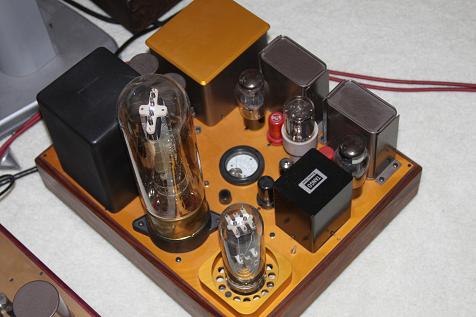
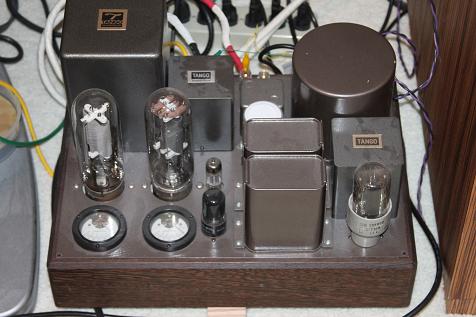
|
|
|
|
Posted by cv on
09-08-2011
|
|
fiogf49gjkf0d Very interesting! (and impressive construction there KO)
I know this isn't quite the subject of the thread, but could you tell a bit more about the 212E amp, in particular, the regulator topology?
Regarding 845 vs 211 - Romy, I suspect what you were hearing was the deficiency of the driver stage with the former...
In any case, I envy KO for having the time and resources to explore both double stacked 57s and horns... good luck (and dont waste too much time with mini-monitors). Macondo Jr was the first time I felt that certain virtues of the 57s were expressed in an otherwise less eccentric, less stunted, package...
Cheers
cv
|
|
|
|
Posted by Romy the Cat on
09-08-2011
|
|
fiogf49gjkf0d KOTriode,
this is not the subject of this thread but I would like to point your attention to one aspect. From one side it looks like you with some kind of special pride talk about your Tango output transformers. From another side you are stupid enough to accumulate many amp (welcome to the club). So, did you think about doing DSET? With DSET topology the output transformers and their special quality is not the subject at all as it is very smile and very cheap to order/buy/build/steal the DSET output transformers that will very much over-perform any imaginary wide-band transformers. You know better then me that any SET amp is VERY simple and chip is not output transformers. So, you need to have a driver that you like. Driver is 75% of SET amp – it, aside from OPT, mostly defines the Sound of amp. Then you can use one channel of your DSET with let say type 10Y tube to drive HF and cheap 6C33C with it ultra low impedance and big inductance, non-sectional OPT to drive bass. You see, with this topology you have no need for big transmission tubes with a lot of power…
The Cat
|
|
|
|
Posted by KOTriode on
09-08-2011
|
|
fiogf49gjkf0d Yes, my friends called me that too, but hey, I can't help it, my curiosity on tube amp get the best part of me, plus I can't build enough power amp to power all my 3 tri-amp system. I collect all kind of transformer, just for the 845, I tried about 6 different type (still have them laying around) before picking what I prefer to use now in my amplifier for some particular tube. For the 6C33C, I used James, it turn out to work pretty well on my bench measurement, someday I will post them.
I have long discussion with a friend about DSET with custom transformer 15 years ago, for sure they will easily outperform the the full bandwidth type by a very large margin if you can find a right iron winder. We order some custom build iron to cover high frequency from 1Khz up, and it was a disaster, so we dropped the idea.
This 6C33C was originally planned as DSET, with simply 2 resistors and 2 cap inserted between the input and cathode follower and it will become DSET.
Regarding big transmission tube, for me they are necessary to power 12" - 15" driver even at 99-100db sensitivity with their 20W-25W output.
|
|
|
|
Posted by oxric on
09-09-2011
|
|
fiogf49gjkf0d Hi KOTriode,
Sorry to take your thread slightly off track but I am in the process of building a multi-way horn system, and for future reference I am looking for someone who might be willing and capable of building an amplifier inspired from Romy's Melquiades schematics for me once my horns are finished. Is amplifier building just a hobby for you or something you might do commercially as well?
If the answer is affirmative, as I see that you have not listed your email address in your profile, would you mind sending me an email to rakeshpoorun@gmail.com? I am in Europe BTW.
Best regards
Rakesh
|
|
|
|
Posted by KOTriode on
09-09-2011
|
|
fiogf49gjkf0d Hello Rakesh,
Sorry, I designed these amp as a hobby just for my own use. I do not plan to make them available commercially, some of the people did copy some of my design and sell them commercially (with astronomically price).
|
|
|
|
Posted by Romy the Cat on
09-09-2011
|
|
fiogf49gjkf0d  oxric wrote: oxric wrote: | | I am looking for someone who might be willing and capable of building an amplifier inspired from Romy's Melquiades schematics for me once my horns are finished. |
|
If I were you then I would not pursue for any amplifier and particularly DSET. If you are building the building a multi-way horn system but build it, drive it from whatever amplifier your have now, get a good sound and good setup of your multi-way in your room. It might take a year or so, then introduce anther, perhaps better amp and begin to evaluate how different amp might or might not benefit the sound of your setup. Without doing it you might end up like that “tuyen” from killerdac.com forum who go over audio devises and audio ideas like US politicians over bumper sticker slogans and do not develop any understanding of what he does. Any new audio solution that you let yourself to be engaged into shall address your personal frustration, objective or demand. If your motivations to go DSET is not backed up by developing you own personal feelings of full-range SET constraint then Is do not consider it as a valid motivation. It might be very much that you will not feel that you need anything else then a good full-range SET.
The Cat
|
|
|
|
Posted by KOTriode on
09-10-2011
|
|
fiogf49gjkf0d
With 6C33C output run at 40W plate dissipation, this amp run much hotter than an 845 amp with output tube running at 100W. I measured the hottest point on the bulb and it is about 380F. I guess the due to short bottle , the heat spread on the chassis make it hotter than the tall 845 bottle. I have to increase fan speed under each tube to cool it down, while on bench , I make some measurement on the amp.
Frequency response at 1W: 10Hz @ -1.37db, 59.1Khz @ -3db. 20Hz @ -0.45db, 20Khz @ -0.3db 10W: 20Hz @ -1.1db, 20Khz @ -0.3db.
This is excellent by SE standard and without negative feedback, better than any tube amp I ever built.
Picture below is square wave performance @ 1W, 100Hz, 1Khz, 10 Khz. The bottom trace is the amp input, the top trace is the amp output.
The last picture , the bottom trace show the grid input of the 6C33C at clipping , the top trace is the output of the amp, the 6C33C can't go into A2 as Romy mentioned.
.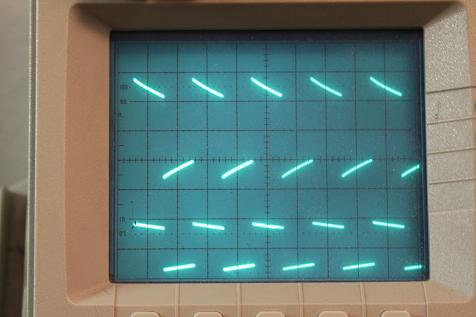
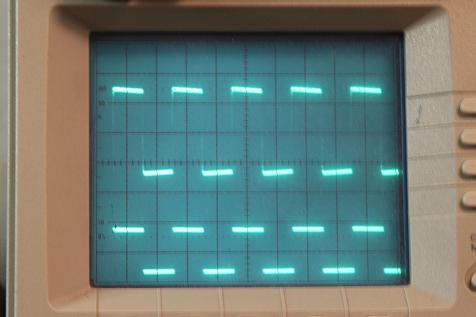
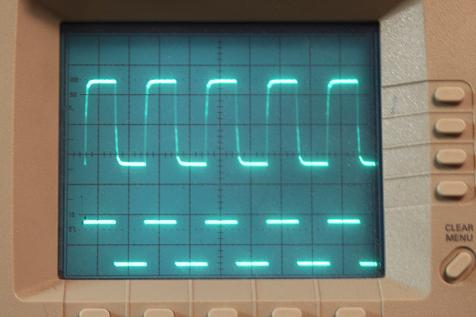
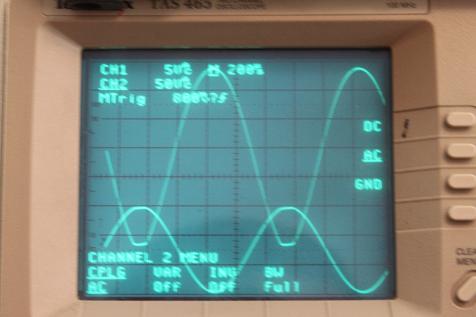
|
|
|
|
Posted by oxric on
09-10-2011
|
|
fiogf49gjkf0d  Romy the Cat wrote: Romy the Cat wrote: |
If I were you then I would not pursue for any amplifier and particularly DSET. If you are building the building a multi-way horn system but build it, drive it from whatever amplifier your have now, get a good sound and good setup of your multi-way in your room. It might take a year or so, then introduce anther, perhaps better amp and begin to evaluate how different amp might or might not benefit the sound of your setup.
The Cat |
|
I hate being responsible for taking this thread away from its real subject, which is KoTriode's Melquiades effort and so will keep this brief.
I would only be looking to have this project started once I get the multi-way system up and running. I would like to find someone who can build the Full-range Melquiades first, and who would then be able to build the D-Set if I am happy enough with its sound and at the time aware of areas where I may wish to do better. I have drawn up a short-list of commercial and non-commercial tube amplifiers that I would like to listen to alongside the Melquiades once I manage to find someone who will build it for me.
Best regards
Rakesh
|
|
|
|
Posted by Romy the Cat on
09-11-2011
|
|
fiogf49gjkf0d
 KOTriode wrote: KOTriode wrote: | With 6C33C output run at 40W plate dissipation, this amp run much hotter than an 845 amp with output tube running at 100W. I measured the hottest point on the bulb and it is about 380F. I guess the due to short bottle , the heat spread on the chassis make it hotter than the tall 845 bottle. I have to increase fan speed under each tube to cool it down, while on bench , I make some measurement on the amp.
Frequency response at 1W: 10Hz @ -1.37db, 59.1Khz @ -3db. 20Hz @ -0.45db, 20Khz @ -0.3db 10W: 20Hz @ -1.1db, 20Khz @ -0.3db.
This is excellent by SE standard and without negative feedback, better than any tube amp I ever built.
Picture below is square wave performance @ 1W, 100Hz, 1Khz, 10 Khz. The bottom trace is the amp input, the top trace is the amp output.
The last picture , the bottom trace show the grid input of the 6C33C at clipping , the top trace is the output of the amp, the 6C33C can't go into A2 as Romy mentioned. |
|
KOTriode, a few things. The 40W plate dissipation is bit too low for both plates. The well heated 6C33C (at least 30 min) you can would drive at 50-55W. If you do not need power and 40W on plate is enough for you then use one anode on the 6C33C, it would be better for thermal operation of the tube and will be positively reflected on sound.
About the measurements. I personally discard any talk about frequency response if the measurements were no done at fool power. You got 10W but I think that with 40W plate dissipation you shell get around 12W. I “feel” that you might have a bit “small” transformer for 6C33C as fractional power I would anticipate better numbers then 20Hz @ -1.1db, 20Khz @ -0.3db. So, in order to speak with the same language I will present my SET frequency response acquisition guide. I am sure it will be nothing new for you or to anybody but for some reason very few people follow this directive and without the very literal follow on this sequence I feel any conversations about frequency response are worthless.
1) Turn amp and heat it for at least 1Hr
2) Connect you loudspeaker, play music and find what tap or combination of sections on your output transformer produce the more proper balance of harmonics within you playback.
3) Recalculate the ratio of your output transformer and find what impedance the output stage sees.
4) Substitute the speaker with 15-20W resistor of the value that would assure output tube to see the same load after the transformer. Let premise it was 12R for instance.
5) Drive 1000Hz into 12R and increase the input voltage until you see very first clipping, from here ad extra 5-10% of input voltage.
6) Measure the response of the driver and assure that driver is not clipping.
7) Using voltage and current on the output tube try to make the clipping symmetrical from top and bottom of the sinusoid. The top way is voltage, the bottom wave is current (or vice versa, I do not remember already). As the symmetrical will be find try to play with operation point more in order to get lessen symmetrical clipping at higher power.
8) If change of voltage and current will get rid of clipping then add more input voltage to drive the amp into clipping again.
9) Let say that the final numbers with perfect symmetrical clipping against the GIVEN IMPEDANCE would be 190V and 280mA winch gives 53W on plate. Now drive more or less input voltage in order to maintain the best symmetrical clipping as amp distort more or less. The objective is that output tube shall starve from voltage and from current identically.
10) Mark the found generator’s output voltage as the reference voltage.
11) Now, as the proper operation point against given load is found drop the input voltage up to the point as the clipping just smoothed out. Switch timing on the scope to faster to see the precise moment the amp stop distort. You need to find a few last mV where amp clips – this will be the true max power of the amp.
12) Without touching the output voltage of your generator increase the frequency of your generator unit you see the very first clip. This would require you to adjust the timing of your scope.
13) From the position of your very first clip drop the generator’s output voltage to 3dB and drive frequency of your generator until you see the very first clipping again. Read the frequency from your generator display. This is the true upper frequency response of your amp at full power
14) Return the generator’s output voltage to the reference voltage and drive the frequency all the way down to the first clipping. Repeat the same ceremony for LF and find he true lower frequency response for your amp against given load.
15) Disregard your “hurt” ego as your frequency response will be not as great as the Morons claims out there. No you will not have 10Hz to 120kHz as some fools claims as you did measure your amp properly and at full power.
Generally an average 6C33C output stage with a proper transformer shell have 20Hz-23Hz at bottom and around 19kH -20kH atop. If you have some VERY good output transformer then you might get in full range operation something like 15-17Hz at about and 25kHz -30kHz. The 17Hz-23kHz at the very fill power of around 16W-17W are VERY good numbers for a full range SET. The Cat
|
|
|
|
Posted by Paul S on
09-11-2011
|
|
fiogf49gjkf0d Well, this methodology would about sink the contemporary hi-fi "industry", wouldn't it? Now try it again into a typical reactive load!
Apart from "spec-driven" design, perhaps the determination to milk the the most possible "power" out of a given circuit is the biggest, reason most amps sound like crap, regardless of "specifications". As a generic observation, no-negative-feedback SET certainly has some sonic advantages; but people have to understand that the whole NNFB SET house of cards is built on real-world speaker efficiency, including load matching. Of course, this methodolgy, and the conclusions drawn from it, are at the heart of evolved multi-channel-HE/DSET...
Best regards,
Paul S
|
|
|
|
Posted by KOTriode on
09-11-2011
|
|
fiogf49gjkf0d Romy,
I ran the tube conservatively at 40W, because it is still breaking in, and I do not want to push it too much power to damage it (then I will have to break-in a new tube all over again). This amp can give max power at 20.35W (12.76Vrms into 8 ohm) with 9.65% distortion, but this is not the kind of power you are "proud" of driving any speaker with (see photo below). At 40W plate dissipation, the amp put out about 10W at 5% distortion, which is a good point to test the amp "real" bandwidth which numbers are more meaningful to me, coincidentally this is what class A is all about, 25% efficiency. My output transformer is rated 30W and 350mA at the primary, so, I still have room to push it for more power, but my 200VA power transformer is inadequate to get more power out of the amp due to power loss for the rectifier/regulation.
"The adjustable current on the tube from 100ma-300ma and 160-220V? Why do you need it? 7) Using voltage and current on the output tube try to make the clipping symmetrical from top and bottom of the sinusoid. The top way is voltage, the bottom wave is current (or vice versa, I do not remember already). As the symmetrical will be find try to play with operation point more in order to get lessen symmetrical clipping at higher power. 8) If change of voltage and current will get rid of clipping then add more input voltage to drive the amp into clipping again "
This is one reason I felt regulator is so convenient with this 6C33C tube, like you mention, I can set the amp to a level I like and adjust the voltage/current for a symmetrical clipping. I can get few more watts by pushing the tube to 250ma, but the voltage now sag close to the point that B+ start loosing regulation.
Below is the photo why I dont rate this amp as 20W
1Khz Sine wave @ 10W
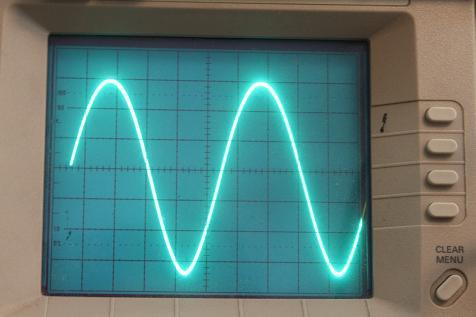
20.35W 1Khz Sine Wave 12.76 Vrms at %10% Distortion
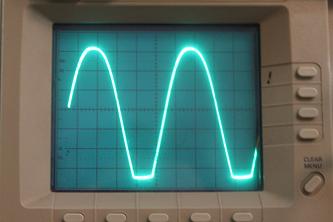
|
|
|
|
Posted by Romy the Cat on
09-11-2011
|
|
fiogf49gjkf0d KOTriode,
…no one questions the usefulness of having a regulator and the ability to adjust voltage and current independently. However, it is necessary ONLY during a design phase and sine you have figure out the optimum operation point for a given tube then this advantage does not exist anymore in my view. As I told the advantage of flexibility is not a valid argument. If you found the right operation pint then drive the tube from regulator and from let say choke-regulated PS at the same operation point then this will be the valid argument of advantage one PS over another.
About the frequency response. You shall be able to get 5% of distortion at max power of 17W -20W but I think you transformation might not be able to do it, I might be wrong. The frequency response that we are talking about is not the frequency response that I care; it is not the “auditable” frequency but rather a circumstantial evidence about your transformer. If you have too soon roll off HF then the transformer has problems with sectioning and with capacitance (along with 25 another possible problems). If you have too soon roll off of bass then your transformer has not enough inductance. Sure you can grow inductance infinitely as it will result grow size and with the low turn you will not be able to fill the core with wire. So, generally with 6C33C driving 600R-900R (your numbers might wary) you have to be able to get with a very good transformer 20W at 5% and 17 kHz-22kHz.
With 40W your plate has too high impedance and you need with 40W 6C33C to drive at least 1200R-1400R of load…. Keep your voltage around 200V and current enough to have 50W-53W on plate. I drive Milq with 240V before choke and have around 195V loaded on plate. The midbass channels I drive with 290mA and 15R load. If I would not need to drive 15” woofers in my midbass horn then I would probably stay with sub 50W on plate and run the tube cooler.
The Cat
|
|
|
|
Posted by KOTriode on
09-15-2011
|
|
fiogf49gjkf0d Totally disappointed today, while I was listening to music, the left channel make a small pop and quit. The bias meter showed about 25ma bias instead of 200ma. Test the tube on bench showed that the tube current stay about 25-50ma max. This tube is gone abrubtly instead of slow death after 31 hours of playing. Took another brand new tube and plug into the amp with just heater power on, nothing! Turn out a brand new tube has dead heater, amazing! Take out another tube, heat the filament for an hour, and check the bias, this time it is less than 100ma, another goner.
Check reliabilty of 6C33C on the net and found this:
I can also sell you a carton of 50 for $900, including ground shipping within the continental US. At this price they are "as is" - I will not replace any which are broken, out of spec or dead (they're a bargain anyway). Reports suggest you can expect 10-20% to be significantly out of spec.
So, it looked like that these tubes left the factory untested and it is up to the buyer to sort them out.
I order some " Ulyanov " tubes on Ebay, anybody have tried them yet? What label of these tubes proven to be reliable?
It is unfortunate that there are reliability issues with these tubes, the last few hour of music showed that the 6C33C has great potential, I was enjoying the music it was making and drawned up plan for a pair of 6C33C's mono block.
|
|
|
|
Posted by Romy the Cat on
09-15-2011
|
|
fiogf49gjkf0d
Well, I would say that “something is wrong” as what you report it is not how it shall be. I had my doubts about the rational to use 6C33C in direct heating coupling but the “danger”
in direct coupling uselessly coming from the plate of the driver tube and from breaking of PS sequencing. Abyhow, I think the problems you are experiencing now are normal for new amp and exposure to new tubes. As both of them mature you shall not have those problems. Let look at what we have in the hands.
 KOTriode wrote: KOTriode wrote: | | Totally disappointed today, while I was listening to music, the left channel make a small pop and quit. The bias meter showed about 25ma bias instead of 200ma. Test the tube on bench showed that the tube current stay about 25-50ma max. This tube is gone abrubtly instead of slow death after 31 hours of playing. |
|
I would call it unlikely. Sure any tube can catastrophically fail and you might be unlucky in this case but I would say that it is most likely not what happened. I would rather blame your regulators and PS then the tube. From the mid 90s I use 6C33C. I use a few BAT amps, few Lamms and few Milqs, in all cases it was multi-amping and I went over many of 6C33C. I have perhaps 2-3 tubes that failed with what I call “catastrophe”. So, I fell the reliability is not the factor for 6C33C at all, in fact it is VERY reliable tube. The stability of the parameters is totally other mater – it might be anything you can imagine but still the tubes with ran way paramagnets in my view are perfectly operational.
Make sure that your PS are reliable and that you do not loose bias supply “at the mid of the night”. Then the sequencing. Here is how it must be: 1) heat the filaments for at least 2 min 2) Apply bias and lock it value. 3) Apply plate voltage. I do not know how bias your 6C33C but I presume that it might have some kind of bug that kills your 6C33C.
 KOTriode wrote: KOTriode wrote: | | Took another brand new tube and plug into the amp with just heater power on, nothing! Turn out a brand new tube has dead heater, amazing! |
|
Never had it I think. What I has however was that the new 6C33C have the pins covered with some kind of protective anti-corrosive shit that does not conduct electricity. It is not to mention that if you use bad tube sockets then the heater female pins might burn up very fast (not after 31 hours of playing of course). So, you need to make sure that you clean/scrub the 6C33C pins what you put need tube in. If there is no ignition on the filament then jerk the tube in the socket vaoalsntly and it will scrub the pink and you will have your filaments back. It is not DHT tube and the filaments are not fragile in this tube. It is impossible to shake this tube to the point that filaments will be damaged.
 KOTriode wrote: KOTriode wrote: | | Take out another tube, heat the filament for an hour, and check the bias, this time it is less than 100ma, another goner. |
|
I do not recognize it as goner. This is very normal and all that you need to do is to drive bias down until the tube gives to you your expected current. The bias amount is absolutely irrelevant for this tube. You might have initial 45V or 110V – that all is normal. As the tube get break-in the bias amount will more come to the more or less expected value. KOTriode, if you remember in my initial reaction to your design I was very skeptical in your idea of direct coupled of 6C33C. In direct coupled applications the plate of driver acts as bias of the output stage. If you are accustomed to nice DTH with stable and predictable expectation of bias then this might not work with 6C33C as this tube has one parameter that is absolutely irrelevant: bias voltage. Take a look in the tube you need to have stable gain (self-explainable), stable plate current (as it set plate impedance). The only one parameter that is not being seen by your speakers is bias. In the situation with fix bias I would like to have max control over bias and unfortunately in case of direct could you have no room to maneuver. If I am right then I have no pleasure in it but if you insist to be direct coupled then you might do some creative tricks. You might for instants to intrude with kind of supplementary bias. It means the let say 50V would come from your driver tube and another adjustable 50V would come from your supplementary bias. This way you will have option to accommodate any 6C33C. In Melquiades can play absolutely any 6C33C. In fact I select the tubes in Milqs ONLY by their gain and I never pay attention to the bias voltage. No matter what current the tube gives when it new I know that I have always reserve bias to set it to be at the expected current.
 KOTriode wrote: KOTriode wrote: | Check reliabilty of 6C33C on the net and found this:
I can also sell you a carton of 50 for $900, including ground shipping within the continental US. At this price they are "as is" - I will not replace any which are broken, out of spec or dead (they're a bargain anyway). Reports suggest you can expect 10-20% to be significantly out of spec. So, it looked like that these tubes left the factory untested and it is up to the buyer to sort them out. I order some " Ulyanov " tubes on Ebay, anybody have tried them yet? What label of these tubes proven to be reliable? |
|
OK, a few things. It is possible, unlikely but possible that during your trip in Asia when you “picked up 4 these tubes for less than $50” you just was given the set of garbage tubes. Some people who use a lot of tubes trash any faulty one and some of them just put it in separate box and the box got filed up then they sell it as “set of tubes”. It is possible that you got your “winning” lottery ticket. I never do it with tubes and if I have any problematic tube I rather break it glass (to avoid temptations to”fix it”) and trash it. However I did it a lot with compression drivers when I was experimenting with them: the drivers that were un-recoverably dead I combined by pairs and sold in far countries…. So, there are a lot of assholes out there…
The comments that you quoted “10-20% to be significantly out of spec” are correct but even being significantly out of spec does not mean the they are not operational as the flexibility to set your custom bias for each out of spec tube make them all perfectly usable. I made a LOT of experiments trying to detect if the 6C33C tube that need 45V bias or 120V bias have any difference in sound. After 100Hr of burn and the bias normalizing to let say 57V bias or 80V respectfully I was not able to detect any sonic distinctions. Another thing: do not believe that anybody would sort them out – no one does it. Well, some do, Vladimir Lamm for instance burn the 6C33C for 72Hr, measures them and match then by gain. So, he used to sell his confirmed 6C33C at $80 a tube and it was 10 years ago. I am sure now he sells them for $180. The Lamm’s tube are fine for some kind of mid-west gynecologist who never saw a screwdriver as he can’t not use it in your work but absolutely no necessary for the people who comfortable to measure plate current and tube gain.
There are few types of 6C33C tubes out there. The Ulyanov tubes are the most common and perhaps 95% of them are made in Ulyanov. There are productions from other plant and by other vintages but they are no better from the perspective of reliability or stability of parameter then Ulyanov. Again if you have full bais control then you shall not have any problems with reliability and stability of 6C33C. Let presume that your “lucky” buy of 6C33C in Asia was just an accident. Hey, I promise you that it was not the last $50 you have lost in audio….
Rgs, Romy the Cat
|
|
|
|
Posted by KOTriode on
09-18-2011
|
|
fiogf49gjkf0d Romy,
I have good confidence that it was the tubes and not the circuit. I have checked the cathode driver that bias the 6C33C and there was not any problem. Sure if the cathode bias failed, the 6C33C current will shoot way up and burned up the fuse, it did not happen in this case. The 6C33C tube went with a small pop, such as you cue the cartridge onto a record, it did not die, but the bias current is way low. I have a total of 8 tubes, after burning in the heater for a day and test the rest of the tubes, now I have only 4 that bias is within 10V of each other. The other 3 is about 30V off, and one did not have conitnuity on 1 filament. Like you said, I probably bought some garbage tubes.
I just order some 6C33C tubes on Ebay: [Edited: link removed.]
because these looked interesting with gold grid wire, none of my 8 tubes I had it. I will test these as soon as I receive them.So far nothing was damaged except the tubes, that is good news. I remember reading somewhere that other tubes like 6AS7 sometimes short the plates, one time at the show, I was listening to an OTL that has about a dozen of these 6AS7 tubes, and one of them sparked with a flash and make a very loud noise on the speaker, I hope the same thing does not happen with the 6C33C in the future.
Anybody out there felt that there is one brand of 6C33C better than other? What about the Svetlana?
|
|
|
|
Posted by Romy the Cat on
09-18-2011
|
|
fiogf49gjkf0d
 KOTriode wrote: KOTriode wrote: | Romy,
I have good confidence that it was the tubes and not the circuit. I have checked the cathode driver that bias the 6C33C and there was not any problem. Sure if the cathode bias failed, the 6C33C current will shoot way up and burned up the fuse, it did not happen in this case. The 6C33C tube went with a small pop, such as you cue the cartridge onto a record, it did not die, but the bias current is way low. I have a total of 8 tubes, after burning in the heater for a day and test the rest of the tubes, now I have only 4 that bias is within 10V of each other. The other 3 is about 30V off, and one did not have conitnuity on 1 filament. Like you said, I probably bought some garbage tubes.I just order some 6C33C tubes on Ebay:
Edited: link removed.
because these looked interesting with gold grid wire, none of my 8 tubes I had it. I will test these as soon as I receive them.So far nothing was damaged except the tubes, that is good news. I remember reading somewhere that other tubes like 6AS7 sometimes short the plates, one time at the show, I was listening to an OTL that has about a dozen of these 6AS7 tubes, and one of them sparked with a flash and make a very loud noise on the speaker, I hope the same thing does not happen with the 6C33C in the future.
Anybody out there felt that there is one brand of 6C33C better than other? What about the Svetlana?
|
|
KOTriode,
way I am not the best person who ask about the reliability of 6C33C as I do not acknowledge the reliability problem for this tube. I have seen this tube failed on OTL applications. I have seen it gone down in PP application as the operational parameters for 6C33C very difficult to match for positive and negative halves. However, I did not see the 6C33C behaved badly in SET applications with output transformer. I did heard the people complain about the reliability of the tube, primary the thermal run out of plate but I did publish the preventive measures for it. So, what I personally experienced is that the 6C33C with preheated filaments and stable fix bias demonstrate absolutely no problems that you describe. BTW, I use to know a number of 6C33C users and I never hear from them any complains about reliability of your type. Again, the reliability is NOT the same as the values of parameters – they might be anything you can imagine with 6C33C. As I told: since I do not recognize the bias voltage as important operational parameter and can accommodate any voltage with my bas type then I do not particularly care about the parameters run of on the new 6C33C. I care only about plate current and gain and they are dead stable year after year. Below is the picture of my amp with currents right in front of it and they run pretty much dally for a few hours.
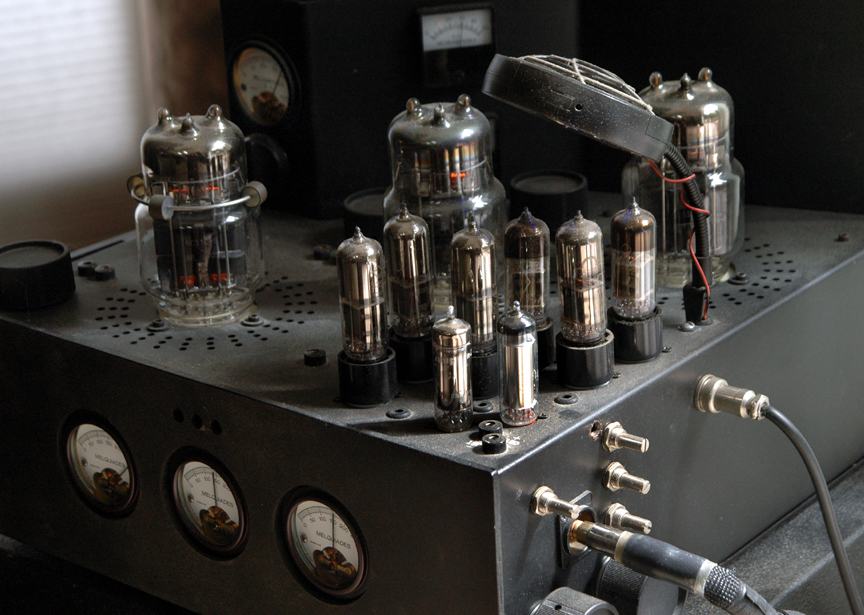
I understand that you do not want to hear my assurances that the tube is reliable if you have problems but since I did not have any problems and do not know the specifics of your circuit then all that I can do is to share my experience. I would tell you even more. I personally, because of some my stupid accident in experiential stags was running the tube at 900mA and 150V for prolong time, dissipating 135W on plate. The tube not only did not go down but I in fact still have this specific tube and the tune is still perfectly operational. If you want more stories then I’ll tell you that I know people in Russia who stupidly believe the 6C33C need to be run at high voltages. Those fools run 6C33C at 650V – twice max permutable for this tube. Reportedly the use it for years and do not complain…
About the different version of 6C33C. I wrote about it in past. I did experiment with many different types of 6C33C but my search was not for reliability (never had problems with that) but for sonic differences. My conclusion is that it was not worthy. I did not see any specific differences between early or late productions, between different manufacturing plans, between different markings, between different “K” marks (Russian equivalent of QA acceptance). They all more of the less were identical in my view. The only reliability problem that I had were the 6C18C – the precursor of the 6C33C. The 6C18C are good sonically but 50% of them I trashed right the way. But if you read Russian specification for 6C33C then you will see that 6C33C was developed to replace the 6C18C and to eliminate the know mechanical problems with 6C18C assembly.
Regarding the tube that you pointed at eBay with gold plate – I thought that I have all 6C33C ever made in my collection but I never had this one. Russians did make the gold plate 6C33C. The gold plates were made for military and in fact only gold plate tubes were use in Mig’s radar power supply (the regular tubes that we use in audio were not used in Migs). It is VERY hard to find the military gold plate tubes nowadays, no one was able to find them yet as far as I know. It was very limited production and they were reportedly given to air force technicians by signature, like bricks of gold in Fort Knox. The advantage of the gold plated grid is that they are able to handle full power right from beginning, with no tendency to overheat, as gold-plating reportedly restricts the secondary emission from the grid of the tube. Will it make any difference in Sound? I do not think so but it needed to be tried. The only obvious advantage is that you shell be able to test this tube at full power and full LF right from a freezer… I still would not do it….. BTW, you need to understand that all my late comments about the sonic quality of 6C33C are made in context of DSET applications. How it would work in context of a full range speakers I do not know. I do not have full range speakers for many years.
The Cat
PS: I took those tubes from Ebay. You said that you have ordered them, so I presume that I did not run the road ahead of you. Let me know if it is OK with you….
|
|
|
|
Posted by Romy the Cat on
09-19-2011
|
|
fiogf49gjkf0d I actually took the remaining dozen of gold grided 6C33C from that eBay guy. It is hard to say what those tubes might be and it is most likely absolutely not necessary in my case. Still, I figured that to get a dozen of 6C33C for a price of a pair of 2A3 is not bad in the end of the day.
Also, I think that made specifically for air force application they might have some other advantages and the military specification was MUCH less tolerable and much more demanding. To the best of my knowledge there were not 6C33C-BP tubes (BP- military acceptance), so my presumption that gold grid s is a closed to the best 6C33C as one can get.
Now, would it have any sonic difference, particularly in my case – I doubt. Still to get them for the price of a single branch in downtown Boston I think is not a bad idea. I do feel that the eBay guy let them go a bit too cheap. The Morons sell Svetlana 6C33C from 1968 for $60-$80 per tubes. I did buy a few and they were absolutely not distinguishable by operation and sound from any other 6C33C. The Gold Grid 6C33C are 1000 less common then early Svetlana, and the guy sell then for $15 a tube… Well, I am game…
BTW, the funny part is that it is very hard (if even possible) to distinguish the Gold Grid from regular one. I think I will need to take one apart to find the piece with my purchase. This is why I got non-even number – to perfume my own 6C33C harakiri ….
The Cat
|
|